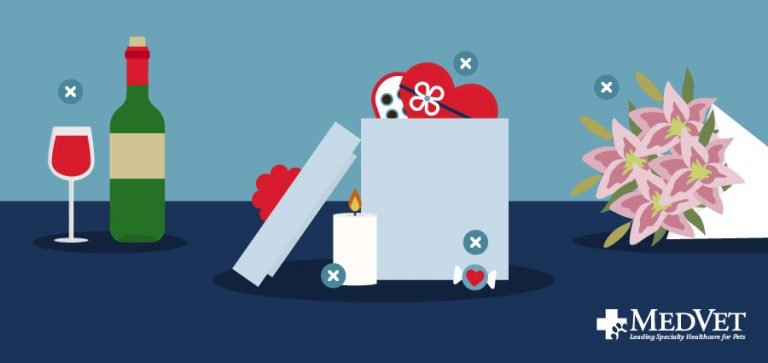
Chocolate-filled hearts. Candles. Flowers. Valentine’s Day is a wonderful time to show others how much you care for them. But some of our favorite gifts are dangerous for your pet. Help keep your pet out of the ER by avoiding these five Valentine’s dangers.
1. Giving flowers? Avoid lilies and watch thorns on roses.
Lilies, including all members of the Lilium and Hemerocallis genera, are highly toxic to cats. The entire plant is dangerous, including the stem, flower, leaves, pollen, and even the water in the vase. A tiny nibble, a lick of pollen-coated paws, or a sip of the water can cause kidney failure in as little as 24 hours or even death. Signs of poisoning include decreased activity level, drooling, vomiting, loss of appetite, dehydration, tremors, and seizures.
Although there is not a direct antidote, treatment to purge the toxins and IV therapy can help your cat survive. Lily toxicity is often fatal unless treated within the first 18 hours following ingestion, so early intervention is key to helping your cat. Contact your veterinarian immediately if you think there’s even a chance that your cat was exposed to a lily. If your family veterinarian is unavailable, seek the help of an Emergency veterinarian such as MedVet.
Another popular flower for Valentine’s Day is the rose. It’s estimated that 224 million roses are grown and sold each year just to celebrate Feb. 14. The biggest danger with roses is the thorns. If your pet bites the stem or steps on it, the thorns can cause a puncture wound than can become infected. Ask your florist to remove the thorns or do your best to remove them yourself, making sure to safely dispose of them, too.
2. Don’t share your chocolate.
Americans purchase about 58 million pounds of chocolate in the week leading up to Valentine’s Day. This delicious-smelling chocolate can be a problem for hungry pets in your home. Why is chocolate so dangerous? Because it contains caffeine and theobromine, which is the most toxic to pets. Humans metabolize these substances just fine, but our pets cannot.
The darker the chocolate, the higher concentration of theobromine, and the more dangerous it is for your pet. Although lighter chocolates and white chocolate typically have less theobromine, they still have a high fat content which can cause gastrointestinal issues and inflammation in the pancreas.
Signs of poisoning include nausea, vomiting, diarrhea, restlessness/hyperactivity, rapid breathing, muscle tension, increased heart rate, and seizures. Untreated, it can lead to heart failure or even death. These poisoning symptoms can take a few hours to show up, and the effects vary based on the amount and type of chocolate and the size of your pet. It’s important to contact your veterinarian right away and try to determine what kind and how much chocolate your pet ingested. Your veterinarian may induce vomiting or use activated charcoal to prevent absorption, a stomach tube to remove the toxic substance, IV fluids to help hydrate, or other treatments and therapies aimed at controlling side effects.
Although chocolate is also dangerous for cats, they are less likely to eat it as they are often more discriminating about what they eat than their chow-hound canine counterparts. Which brings up one additional concern. Most enthusiastic pets aren’t taking the time to unwrap the chocolate they find. If your pet ingests a wrapped chocolate (or candy for that matter), the foil or plastic wrappers can lodge in their throat or digestive track, often requiring surgery to remove.

3. Beware of artificial sweeteners
Sometimes we give gifts to our sweetie that aren’t quite as sweet. While sugar-free treats are fine for humans, artificial sweeteners can be toxic for our pets. Xylitol is a sugar-free sweetener often used in chewing gum, baked goods, and many other products like toothpaste, jams, breath mints, vitamins, and even some types of peanut butter. In both humans and animals, the pancreas releases insulin to help regulate blood sugar. When humans eat products with xylitol, their bodies do not produce insulin. However, when dogs ingest xylitol, it triggers the rapid release of insulin which can create a dramatic drop in blood sugar. The effect varies based on the size of the dog and the amount ingested.
Xylitol poisoning symptoms typically develop soon after it’s ingested and include vomiting, weakness, lethargy, lack of coordination, tremors, or seizures. Extremely low blood sugar can lead to seizures and eventually cause liver failure or even death. Timely treatment is key. If you suspect your pet has eaten something containing xylitol, you should contact your veterinarian immediately.
There is no antidote for xylitol poisoning, but your pet may be treated for low blood sugar and any other symptoms. Your veterinarian (or an emergency veterinarian) may induce vomiting depending on the amount of xylitol ingested. Never induce vomiting on your own without first speaking to your veterinarian. It’s important to read labels and ensure that any product containing xylitol is kept away from your pet.
4. Use candles safely
Gleaming candlelight sets a romantic mood that can be disrupted quickly by a curious pet should the candle be knocked over and start a fire. Your pet can also get a burn if they get too close.
Smoke from candles can also potentially irritate your pet’s respiratory system, especially if they have asthma or other respiratory issues. And, just like there are smells you might not like, your pet may have an aversion to some scents.
If you do use candles, keep them away from your pets and never leave your pet unattended in a room with a lit candle. Looking for a safe alternative? Try battery-operated, flameless candles instead. Or try cleaner-burning candles made from soy, beeswax, or vegetable wax.

5. Keep alcohol to yourself.
A champagne toast or crafty cocktail may top off dinner with your Valentine, but spirited drinks don’t mix with your pets. Beer, wine, or any kind of liquor, even small amounts, can be harmful. This includes alcohol-based desserts, too! Pets are affected much the way that humans are from alcohol, but it is extra dangerous because they weigh less and their bodies don’t break down the alcohol the same way that humans do.
Pets experiencing alcohol poisoning may be wobbly, nauseous, vomit, or have other gastrointestinal issues. The danger is not in what type of drink it is, but the amount consumed. Small doses may not require medical help, but if you see any clinical symptoms, you should contact your veterinarian.
In all situations, early treatment is important. If you think your pet has come in contact with any of these five dangers, seek help right away. Call the Pet Poison Helpline at 855-764-7661, your family veterinarian, or visit your nearest MedVet.

